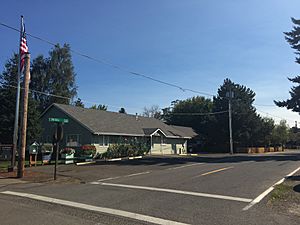Donald, Oregon facts for kids
Quick facts for kids
Donald, Oregon
|
|
|---|---|

Donald City Hall
|
|

Location in Oregon
|
|
| Country | United States |
| State | Oregon |
| County | Marion |
| Incorporated | 1912 |
| Area | |
| • Total | 0.38 sq mi (0.98 km2) |
| • Land | 0.38 sq mi (0.98 km2) |
| • Water | 0.00 sq mi (0.00 km2) |
| Elevation | 197 ft (60 m) |
| Population
(2020)
|
|
| • Total | 1,009 |
| • Density | 2,662.27/sq mi (1,027.57/km2) |
| Time zone | UTC-8 (Pacific) |
| • Summer (DST) | UTC-7 (Pacific) |
| ZIP code |
97020
|
| Area code(s) | 503 |
| FIPS code | 41-20100 |
| GNIS feature ID | 2410344 |
Donald is a small city in Marion County, Oregon, United States. About 1,000 people live there, based on the 2020 census. It is part of the larger Salem Metropolitan Statistical Area, which means it's connected to the city of Salem.
Contents
Exploring Donald's Location
Donald is located in Oregon. The city covers a total area of about 0.22 square miles (0.57 square kilometers). All of this area is land. Donald is also found along the path of the Oregon Electric Railway, which has been important to its history.
Donald's Past: A Look Back
Donald has a long and interesting history, especially with farming and industry. Farmers and loggers from the Midwest first settled here between 1840 and 1860.
How Donald Got Its Name
In the early 1900s, Donald became a major stop for the Oregon Electric Railway. The city was named after R. L. Donald. He was an engineer who worked for the company that built the railway.
Early Growth and the Railway
The town of Donald was created from land claims sold by R. L. Donald in 1908. At first, the community focused on growing hops, which are used to make beer. The town really started to grow when the Oregon Electric Railway built a substation and a depot (a train station) in Donald. This was completed in 1906. Donald was an important stop on the main railway line between Salem and Portland.
Changes Over Time
A post office opened in Donald on April 13, 1910. The town also had a brick and tile factory from 1911 to 1923. However, when Highway 99W was paved, fewer people rode the railway. The electric passenger train service stopped in Donald on May 14, 1933. Because of this, the population dropped from 300 to just 100 people.
Later, the railway switched to steam power in 1947 and then to diesel power in 1948. In 1970, the rail line became part of Burlington Northern. Today, the rail line is still used a lot by the Portland and Western Railroad.
People of Donald
| Historical population | |||
|---|---|---|---|
| Census | Pop. | %± | |
| 1920 | 126 | — | |
| 1930 | 114 | −9.5% | |
| 1940 | 164 | 43.9% | |
| 1950 | 187 | 14.0% | |
| 1960 | 201 | 7.5% | |
| 1970 | 231 | 14.9% | |
| 1980 | 267 | 15.6% | |
| 1990 | 316 | 18.4% | |
| 2000 | 612 | 93.7% | |
| 2010 | 979 | 60.0% | |
| 2020 | 1,102 | 12.6% | |
| 2022 (est.) | 1,179 | 20.4% | |
| U.S. Decennial Census | |||
The city of Donald has grown quite a bit over the years. In 2010, there were 979 people living there. These people lived in 347 households, with many of them being families.
Donald's Population in 2010
In 2010, the city had about 4,450 people per square mile (1,718 people per square kilometer). Most residents were White, but there were also people from other racial backgrounds. About 14.6% of the population was Hispanic or Latino.
Many households had children under 18 living with them. Most households were married couples living together. The average age of people in Donald was about 38.9 years old.
Learning in Donald
Students in Donald attend schools within the North Marion School District. This includes going to North Marion High School.
See also
In Spanish: Donald (Oregón) para niños

